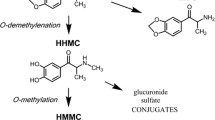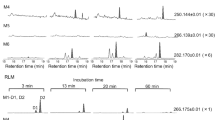Abstract
(—)-Deprenyl is a selective irreversible inhibitor of MAO-B. The parent compound is responsible for the enzyme inhibitory effect, but its metabolites are also playing a role in the complex pharmacological activity of the substance. In the present studies male NMRI mice were treated orally, subcutaneously, intraperitoneally and intravenously with 5mg/kg of (—)-deprenyl. The time related changes of the plasma concentrations of the parent compound and its main metabolites (methamphetamine, desmethyl-deprenyl and amphetamine) were determined by GC/ MSD technique. The main pharmacokinetic parameters (Cmax, tmax, t1/2 β, AUC0–6, AUC0-∞) have been calculated. (—)-Deprenyl is well absorbed after oral and parental treatment. The peak concentrations (Cmax) were reached at 15 min after treatment and the absorption was followed by a fast elimination (t1/2 β ≤ 2h). (—)-Deprenyl has an intensive “first pass” metabolism after oral treatment; only 25% of the parent compound reaches the systemic circulation. Increased bioavailability was detected after subcutaneous (87.1%) and intraperitoneal (78.7%) administration. The main metabolic pathway of (—)-deprenyl is the N-depropargylation, leading to the formation of methamphetamine. N-demethylation of (—)-deprenyl leads to formation of desmethyl-deprenyl. Amphetamine is produced from both former metabolites.
Access this chapter
Tax calculation will be finalised at checkout
Purchases are for personal use only
Preview
Unable to display preview. Download preview PDF.
Similar content being viewed by others
References
Birkmayer W, Knoll J, Riederer P, Youdim MBH, Hars V, Martin J (1985) Increased life expectancy resulting from addition of L-deprenyl to Madopar® treatment in Parkinson’s disease: a long-term study. J Neural Transm 64: 113–128
Carillo MC, Kanai S, Nokubo M, Kitani K (1991) (—)-Deprenyl induces activities of both Superoxide dismutase and catalase but not of glutathione peroxidise in the striatum of young male rats. Life Sci 48: 517–521
Finnegan KT, Skratt JJ, Irwin I, DeLanney LE, Langston JW (1990) Protection against DSP-4-induced neurotoxicity by deprenyl is not related to its inhibition of MAO B. Eur J Pharmacol 184: 119–126
Gaál J, Szebeni Gy, Székács G, Fejér E, Wágner Ö, Szatmári I, Magyar K, Mezei M (2000) Transdermal formulations of deprenyl: guinea pig and pig models. Neurobiology 8(2): 143–166
Gordon MN, Muller CD, Sherman KA, Morgan DG, Azzaro AJ, Wecker L (1999) Oral versus transdermal selegiline antidepressant-like activity in rats. Pharmacol Biochem Behav 63(3): 501–506
Haberle D, Szökő É, Magyar K (2002) The influence of metabolism on the MAO-B inhibitory potency of selegiline. Curr Med Chem 9: 47–51
Heinonen EH, Myllyla V, Sotaniemi K, Lammintausta R, Salonen JS, Anttila, M et al (1989) Pharmacokinetics and metabiolism of selegiline. Acta Neurol Scand 126: 93–99
Knoll J (1989) The pharmacology of selegiline ((—)-deprenyl). New aspects. Acta Neurol Scand Suppl 126: 83–91
Knoll J, Magyar K (1972) Some puzzling pharmacological effects of monoamine oxidase inhibitors. In: Costa E, Sandier M (eds) Monoamine Oxidases — new vistas. Adv Biochem Psychopharmacol, Vol. 5. Raven Press, New York, pp 393–408
Knoll J, Ecseri Z, Kelemen K, Nievel J, Knoll B (1965) Phenylisopropylmethyl-propinylamine (E-250), a new spectrum psychic energizer. Arc Int Pharmacodyn Ther 155: 154–164
Langsten JW (1980) Selegiline as neuroprotective therapy in Parkinson’s disease: concepts and controversies. Neurology Suppl 3 40: 61–66
Lengyel J, Magyar K, Hollósi I, Bartók T, Báthori M, Kalász H, Fürst S (1997) Urinary excretion of deprenyl metabolites. J Chromatorgr A 762(1–2): 321–326
Magyar K (1993) Pharmacology of monoamine oxidase type-B inhibitors. In: Szelényi I (ed) Inhibitors of monoamine oxidase B: pharmacology and clinical use in neurodegenerative disorders. Birkhäuser, Basel, Switzerland, pp 125–143
Magyar K (1994) Behaviour of (—)-deprenyl and its analogues. J Neural Transm Suppl 41: 167–175
Magyar K (1997) The role of the metabolism of (—)-deprenyl in neuro-protection. In: Teelken AW, Korf J (eds) Proc 1 1th ESN Meeting. Neurochemistry section 12: Neuroprotection and neurorescue: myths and mechanisms, pp 303–308
Magyar K, Haberle D (1999) Neuroprotective and neuronal rescue effects of selegiline: review. Neurobiology 7(2): 175–190
Magyar K, Szende B (2000) The neuroprotective and neuronal rescue effect of (—)-deprenyl. In: Cameron RG, Feuer G (eds) Handbook experimental pharmacology, Vol. 142. Springer, Berlin Heidelberg New York Tokyo, pp 457–472
Magyar K, Vizi ES, Ecseri Z, Knoll J (1967) Comparative pharmacological analysis of the optical isomers of phenyl-isopropyl-methyl-propinylamine (E-250). Acta Physiol Acad Sci Hung 32(4): 377–387
Magyar K, Lengyel J, Szatmári I, Gaál J (1995) The distribution of orally administered (—)-deprenyl-propynyl-14C and (—)-deprenyl-phenyl-3H in rat brain. Progress Brain Res 106: 143–153
Magyar K, Szende B, Lengyel J, Tekes K (1996) The pharmacology of B-type selective monoamine oxidase inhibitors; milestones in (—)-deprenyl research. J Neural Transm Suppl 48: 29–43
Magyar K, Szende B, Lengyel J, Tarczali J, Szatmáry I (1998) The neuroprotective and neuronal rescue effects of (—)-deprenyl. J Neural Transm Suppl 52: 109–123
Magyar K, Pálfi M, Tábi T, Kalász H, Szende B, Szökő É (2004) Pharmacological aspects of (—)-deprenyl. Curr Med Chem 11: 2017–2031
Olanow CW, Godbold JH, Koller W (1996) Effect of adding selegiline to levodopa in early, mild Parkinson’s disease: patients taking selegiline may have received more levodopa than necessary. BMJ [Letter] 312: 702–703
Parkinson’s Study Group (1993) Efects of Tocopherol and deprenyl ont he progression of disability in early Parkinson’s disease. NEJN 328: 176–183
Patkar AA, Pae CU, Masand PS (2006) Transdermal selegiline: the new generation of monoamine oxidase inhibitors. CNS Spectr 11(5): 363–375
Reynolds GP, Elsworth JD, Blau K, Sandler M, Lees AJ, Stern GM (1978) Deprenyl is metabolized to methamphetamine and amphetamine in man. Br J Clin Pharmacol 6: 542–544
Ricci A, Mancini M, Strocchi P, Bongrani S, Bronzetti E (1992) Deficits in cholinergic neurotransmission markers induced by ethylcholine mustard aziridium (AF64A) in the rat hippocampus: sensitivity to treatment with the monoamine oxidase-B inhibitor l-deprenyl. Drugs Exptl Clin Res VIII(5): 163–171
Schächter M, Marsden CD, Parkes JD, Jenner P, Testa B (1980) Deprenyl in the management of response fluctuations in patients with Parkinson’s disease on levodopa. J Neurol Neurosurg Psychiatry 43: 1016–1021
Szökő É, Magyar K (1995) Chiral separation of deprenyl and its major metabolites using cyclodextrin-modified capillary zone electrophoresis. J Chromatogr A 709(1): 157–162
Szökő É, Magyar K (1996) Enantiomer identification of the major metabolites of (—)-deprenyl in rat urine by capillary electrophoresis. Int J Pharmacol Adv 1(3): 320–328
Tatton WG, Ju WYL, Holland DP, Tai C, Kwan M (1994) (—)-Deprenyl reduces PC12 cell apoptosis by inducing new protein synthesis. J Neurochem 63: 1572–1575
Tatton WG, Chalmers-Redman RME (1996) Modulation of gene expression rather than monoamine oxidase inhibition: (—)-deprenyl-related compounds in controlling neurodegeneration. Neurology 47 Suppl 3: S171–S183
Waldmeier PC, Boulton AA, Cools AR, Kato AC, Tatton WG (2000) Neurorescuing effects of the GAPDH ligand CGP 3466B. J Neural Transm Suppl 60: 197–214
Author information
Authors and Affiliations
Editor information
Editors and Affiliations
Rights and permissions
Copyright information
© 2007 Springer-Verlag
About this paper
Cite this paper
Magyar, K., Szatmáry, I., Szebeni, G., Lengyel, J. (2007). Pharmacokinetic studies of (—)-deprenyl and some of its metabolites in mouse. In: Gerlach, M., Deckert, J., Double, K., Koutsilieri, E. (eds) Neuropsychiatric Disorders An Integrative Approach. Journal of Neural Transmission. Supplementa, vol 72. Springer, Vienna. https://doi.org/10.1007/978-3-211-73574-9_21
Download citation
DOI: https://doi.org/10.1007/978-3-211-73574-9_21
Publisher Name: Springer, Vienna
Print ISBN: 978-3-211-73573-2
Online ISBN: 978-3-211-73574-9
eBook Packages: MedicineMedicine (R0)




